WILL THE REAL FIREFLY PLEASE STAND UP?
Bugs That Get Confused With Fireflies—And How to Tell the Difference
If it’s tiny, winged, and flashing in your backyard, it might be a firefly—but it might not. Other species of bugs also glow and use bioluminescence to communicate, find mates, and scare off predators. Here are a few bugs that are commonly misidentified as fireflies—and how to tell the difference.
Deilelater physoderus (Germar)
Glowing Click Beetles
It glows, but it isn’t a firefly. It’s actually a type of click beetle, dark brown. It is known as the “headlight elator” because its lights are on its head; they have two small bioluminescent light organs at the back of the head and one under their abdomen. Fireflies, however have glowing abdominal segments.

Like firefly larvae, their larvae are also bioluminescent. Unlike fireflies, these glowing click beetles don’t flash. However, they do seem to be able to control the intensity of the light they emit. When touched by a possible predator, for example, they become brighter. There are 3 species north of Mexico and 2 species in FL-GA region. South Texas offers the best opportunity to see these insects. Worldwide this family is well diversified in Central and South America.
Larvae of this species eat both plants and invertebrate animals, including the larvae of other species of beetle. Adults eat fermenting fruit, pollen, and smaller insects. That’s another way you can tell the difference between these and fireflies—adult fireflies are rarely, if ever, seen feeding.
Railroad worms
Railroad worms
Found in both North and South America, these bugs and their larvae emit both green and red light—they’re the only bioluminescent insects that emit red light. The green lights are lined up along the insect’s body, while the red lights are on its head. The red light comes on when the animal is jostled or threatened—possibly to warn off predators.

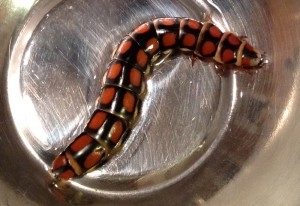
Mecas rotundicollis (Thomson)
Firefly-mimicking Longhorn Beetle
Probably one of the single best firefly mimics. Not only does this type of Longhorn beetle resemble a firefly in size, shape, and color, it even mimics the light-producing abdominal segments with striking similarity to a firefly. Notice how this beetle has two yellow colored abdominal segments. Fireflies also commonly have two yellow colored light producing segments. Amazing!
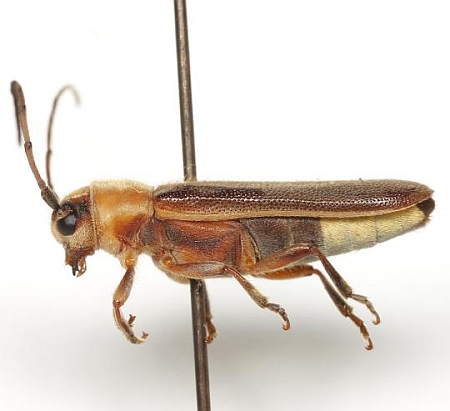
Copyright © Mike Quinn
Buprestidae
Yellow-bordered Flower Buprestid
It looks like a firefly in the daytime but is it? This beetle bears a striking similarity to a firefly but it’s not one. The scientific name for this beetle is Acmaeodera flavomarginata, often listed in books as the Yellow-bordered Flower Buprestid, the term buprestid designating the beetle family to which it belongs, Buprestidae. This insect is an amazing example of mimicry, where another beetle mimics the colors of a firefly as a defense not to get eaten. Fireflies contain steroid like compounds that are poisonous to many animals and other insects. These beetles are occasionally found on flowers and are known to be pollinators. The red blotch across the beetle’s rear end is very similar to such patches on the front ends of fireflies. The yellow on the edges of its wing cover also mimic fireflies yellow coloration on their thorax. This particular beetle was found on a frostweed weed plant located in New Braunfels, TX (Fall 2015).
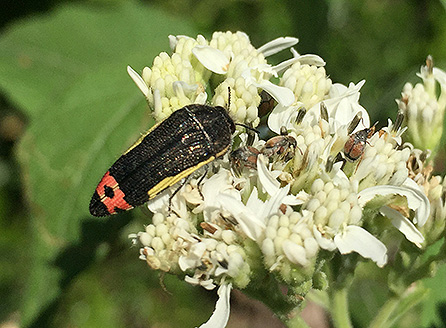
Drilidae
Drilidae
These bugs are not bioluminescent—but other than that, many species look a lot like fireflies; so much so that they are sometimes referred to as “false firefly beetles.” There are many species, and some have very obvious sexual dimorphism in Selasia unicolor, an African species of Drilidae, the female is ten times bigger than the male. Females are wingless and look more like caterpillars than the beetles they are.
Soldier beetles
Soldier beetles
These are also not bioluminescent, but they also look a lot like fireflies other than that and are related to the firefly family. A variation of the species found in Europe is bright red, reminding the British of red-coated soldiers—hence the name. They are also referred to as “leatherwings” because of the leather-like texture of the wing covers on some species.

The following image is a great example of a soldier beetle that is mimicking a firefly. Notice how the colors on it’s head look very similar to the colors of a firefly head even down to the red, yellow, and black spot in the middle. The dark color on it’s thorax is also very similar to many species of fireflies. Some solider beetles such as Chaulognathus pennsylvanicus (DeGeer) also superficially resemble fireflies in body shape and look. They have a yellow coloration with black marking on each wing cover.
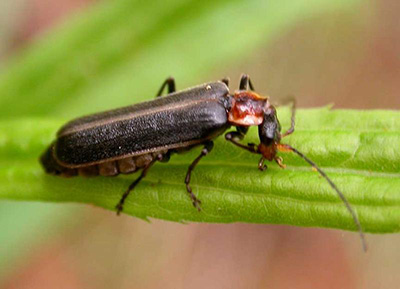
Glowing cockroaches
Glowing cockroaches
If you’ve seen this cockroach and confused it with a firefly, you were very, very lucky. Unfortunately, there is no such thing as a truly bioluminescent cockroach. Despite initial reports of the cockroach’s ability to glow, a group of researchers and bioluminescence experts conducted tests on live specimens to determine if the cockroach species (Lucihormetica luckae) was indeed bioluminescent. Their finding: none of the cockroaches emitted any measurable light (Merritt 2013). Their conclusions have been confirmed by several others since then, which effectively rules out the possibility that luminous cockroaches exist.
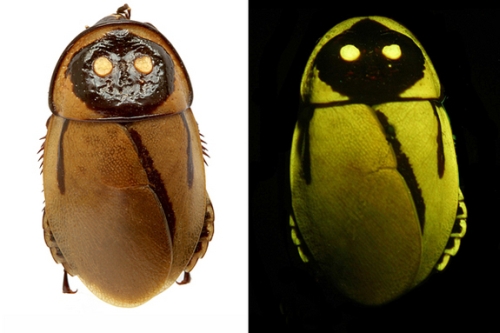
So what made people think that these cockroaches could glow in the first place? It may be due to a rare and real phenomenon, not one, however, based on the cockroach’s own ability to produce biological light, but on the presence of pathological bacteria (known for almost 100 years to attack insects, especially caterpillars: Pfeiffer & Stammer 1930). The back of this cockroach’s carapace is decorated with three spots—one large, two small— that glow when exposed to light (autofluorescence). This bacteria could preferentially colonize specific areas of the cockroach like those that cannot easily be reached by the cockroach when cleaning itself. Some have suggested that the glowing spots on the back of the cockroach could be an instance of Batesian mimicry. The glowing spots could ward off predators by mimicking a type of toxic glowing click beetle (Deilelater sp.) that tastes bad to most predatory species.
If it looks like a firefly—and if it glows—it’s not necessarily a firefly. Bioluminescence is rarer on land than in the water, but there are several species of bug that emit their own light in addition to fireflies. Some do it through chemical processes that take place in their bodies, as fireflies do—others, such as the exceedingly rare glowing cockroach, rely on bioluminescent bacteria. No matter how they do it, however, they’re all beautiful in their own way—and fascinating.